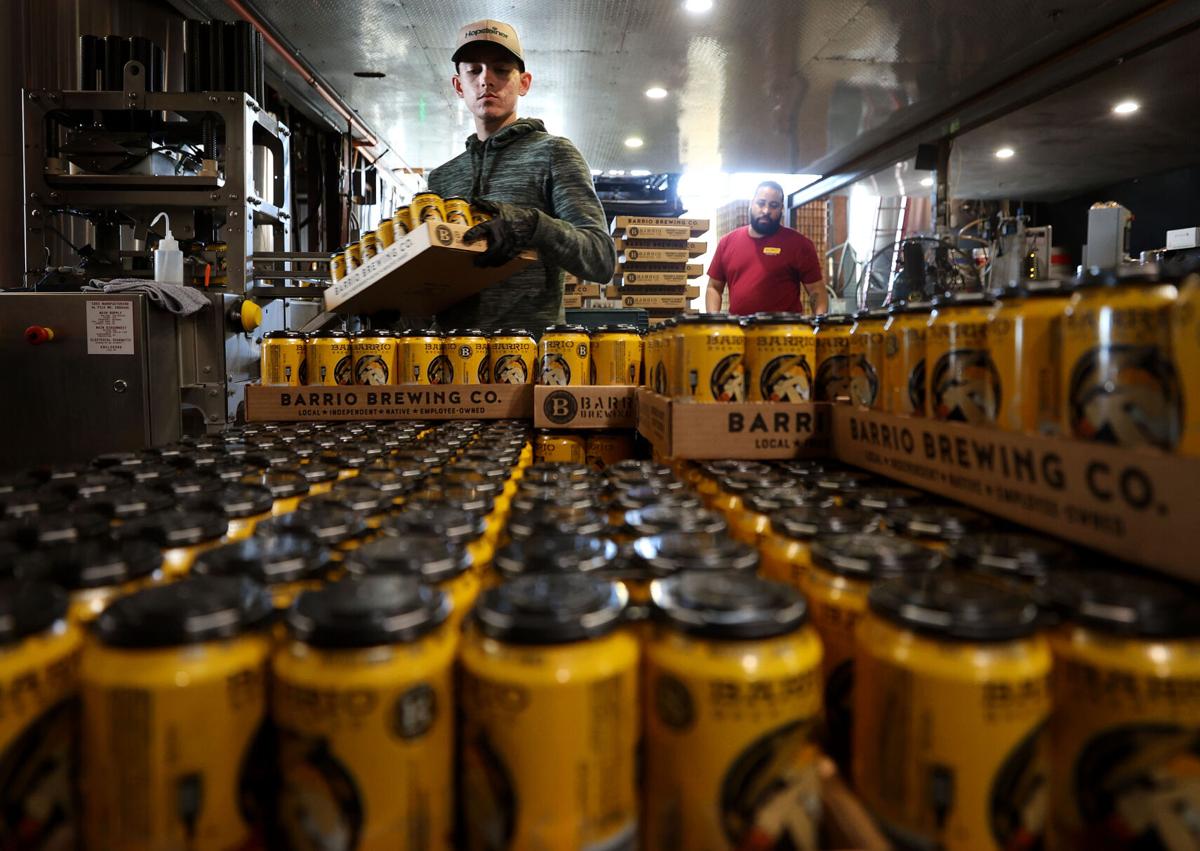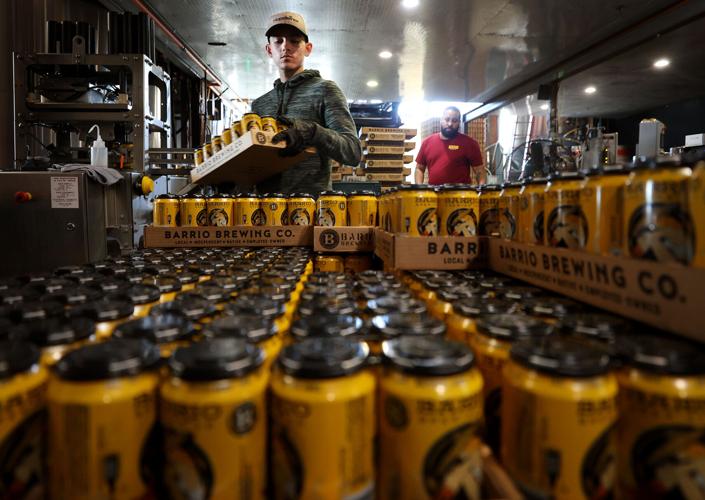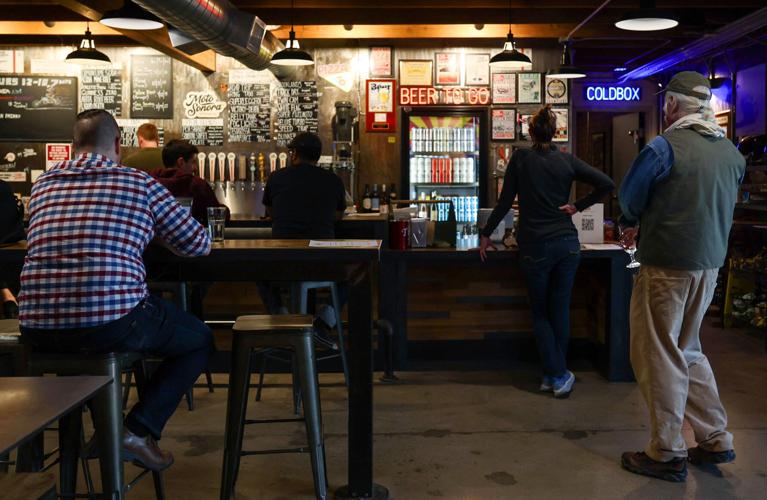. had no choice but to invest in expensive equipment and can its Victory or Death IPA and Fog Lights Hazy IPA when brothers Jeff and Jeremy DeConcini opened just weeks before the COVID-19 pandemic in 2020.
But what seemed like a great way to introduce their beer to ┤¾Ž¾APPconsumers who couldnŌĆÖt come to the brewery has become somewhat of an albatross after President Trump slapped a 25% tariffs on CanadaŌĆÖs steel and aluminum.
ŌĆ£At our scale, we are very sensitive to the price of aluminum,ŌĆØ said Jeremy DeConcini, who said he didnŌĆÖt know yet how the tariff will impact his costs. But any increase ŌĆ£will mean we canŌĆÖt sell as much far and wide,ŌĆØ he said.

Customers enjoy local brews at Moto Sonora Brewing Company, 1015 S. Park Avenue.
American manufacturers get 60% of their aluminum from Canada, which means higher prices for cans on top of the steadily increasing costs for malt, hops and grains needed to make beer.
People are also reading…
┤¾Ž¾APPcraft breweries say TrumpŌĆÖs tariff could put a hurt on an industry already facing an uphill battle to stay viable in a shrinking marketplace. Beer sales, like sales of wine and spirits, has seen a dramatic decline in the past two years as consumers opt out of drinking alcohol.
ŌĆ£The bubble for craft brewing is over,ŌĆØ said owner Es Teran, pointing to two recent ┤¾Ž¾APPbrewery closures ŌĆö Dillinger Brewing in late 2023 after seven years and Firetruck Brewing in late January after 14 years.
ŌĆ£ThereŌĆÖs different reasons, but people extended themselves at the pandemic and at the same time, the consumers have changed,ŌĆØ he said. ŌĆ£People are drinking seltzers or mocktails.ŌĆØ
Legalized recreational marijuana also has cut into the market, he said, echoing an argument Southern Arizona winegrowers made last year as many saw a dramatic drop in sales.
ŌĆ£You can take an edible and drink a soda and youŌĆÖre having a good time,ŌĆØ Teran said. ŌĆ£I think we have to adapt, and at the end of the day, you have to cut some costs. The cost right now is in the packaged.ŌĆØ

Cans of Barrio Blonde get filled during the canning process at TucsonŌĆÖs Barrio Brewing.
Borderlands, which opened in 2010, took that step last September when it stopped canning its beers.
ŌĆ£We were losing money,ŌĆØ Teran said. ŌĆ£While it gave us brand exposure and we were able to get a lot more presence in the market, it didnŌĆÖt make financial sense. We just werenŌĆÖt making any money at that point.ŌĆØ
cans 45% of the 13,000 barrels of beer it produces annually, distributing Citrazona Indian Pale Ale, Hipsterville Hazy IPA and its popular ┤¾Ž¾APPBlonde to stores statewide. The brewery, the stateŌĆÖs oldest and fifth largest, was the first to can its beers back in 2013.
ŌĆ£At the time, canning wasnŌĆÖt a popular thing,ŌĆØ said Barrio CEO Jaime Dickman. ŌĆ£It was more glass bottles.ŌĆØ
Because of its size, Barrio is able to lock in price contracts to soften the economic blow from price increases. Before the tariffs went into play, Barrio ordered three truckloads of pre-printed cans. That should be enough to take the brewery through the year, Dickman said, although they werenŌĆÖt able to get as many ┤¾Ž¾APPBlonde cans as they will need. Blonde is the breweryŌĆÖs most popular beer.
ŌĆ£ThatŌĆÖs where we are going to take on these tariff costs is for the Blonde cans,ŌĆØ she said.
Barrio Brewing has no plans to cut back on its canning but it is looking at other steps in its beer-making process where it can cut costs. The goal, Dickman said, is to maintain the price point for consumers.
ŌĆ£ItŌĆÖs hard to raise prices when they already are spending $12 for a six pack when they can get a macro-brewed six pack for half the cost,ŌĆØ she said. ŌĆ£We are really trying to do whatever we can to keep our costs down.ŌĆØ
is hoping the impact from the tariff will sidestep them. They buy their cans from a manufacturer in Chicago that uses American aluminum, including recycled aluminum, said owner Kyle Jefferson.
So far, the company hasnŌĆÖt heard if their supplier plans to raise prices, said Jefferson, who opened the brewery with Linette Antillon in 2014; they started canning their beers two years later.
Pueblo Vida, which brews 1,250 barrels a year, has created more than 250 unique cans in the past 8┬Į years, including its red and blue Wildcat Sonoran-style Cerveza, a collaboration with the University of Arizona. Roughly 60% of its sales are from canned beers sold locally at Total Wine & More, Sprouts and Whole Foods, which also carries the beers statewide.
Jefferson said any price increases will hurt his bottom line.
ŌĆ£Margins are thin and you can see that in food and beverage everywhere,ŌĆØ he said. ŌĆ£Any price increase that we get weŌĆÖre trying to absorb because our F&B customers are struggling and our consumers are struggling.ŌĆØ
The margins are especially thin for newcomers like MotoSonora, which produces about 1,200 barrels a year.
The southside brewery, which just marked its fifth anniversary, kegs 75% of its beer for draft sales, including from its microbrewery at 1015 S. Park Ave. It cans the remaining 25%, paying an average 30 cents per can, and that beer often competes for consumer attention on store shelves alongside less expensive nationally known macrobrews.
ŌĆ£If I sell it to my distributor, he sells it to Whole Foods and it sits on a shelf,ŌĆØ DeConcini said. ŌĆ£WeŌĆÖve been canning for four years. Had I to do it all over again, I wouldnŌĆÖt have focused on (canning) so much knowing what I know now.ŌĆØ
BorderlandsŌĆÖ Teran is considering taking a page from the craft brewing industryŌĆÖs past to navigate the future as he looks to bring back growlers.
ŌĆ£In reality, the whole canning business started in the pandemic, but before that growlers were the way to go,ŌĆØ said Teran, who has owned the brewery since 2018. ŌĆ£That was a pretty niche and cool thing about the craft brewing industry, which was different from the normal brewing industry.ŌĆØ















